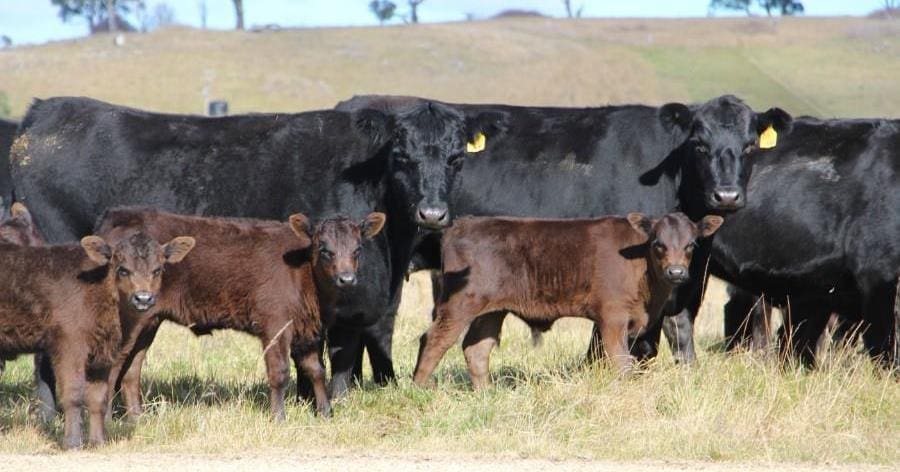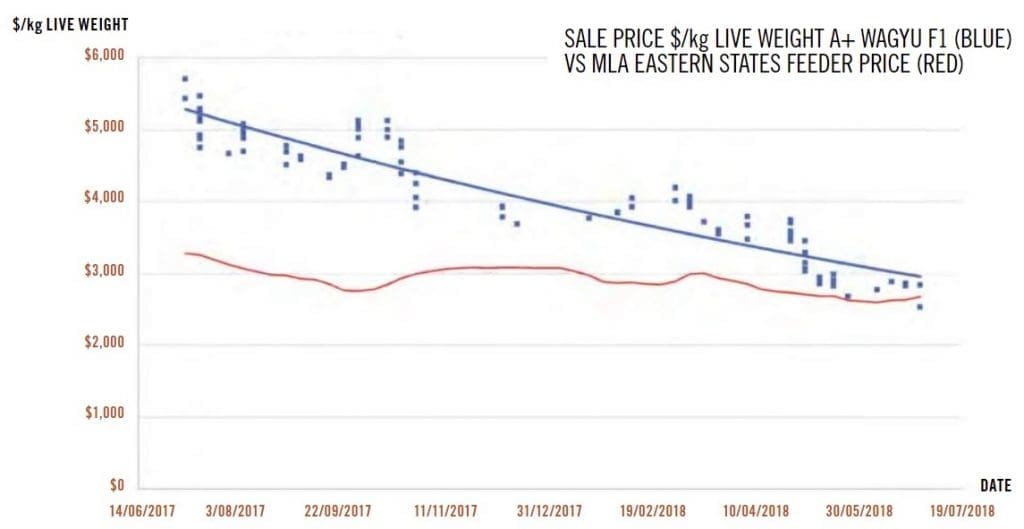
Angus cows with Wagyu x calves at foot
WAGYU F1 feeder cattle prices have come under heavy pressure over the past 12 months, due to a combination of record-high grain prices adding substantially to production cost, and over-supply of less desirable F1 feeders.
That’s the view gained from a sample of some of the nation’s largest Wagyu grainfed beef supply chains approached by Beef Central this week.
According to four large supply chains in NSW and Queensland, the market for good quality F1 Wagyu x Angus feeder steers presently is around 320-350c/kg liveweight, with 20c/kg less for heifers.
After years where massive premiums were being paid for Wagyu crossbreds over other breeds, that premium is currently only about 10-20c/kg above equivalent Angus feeders – and a long way from the prices consistently above 500-600c for F1s at the height of the market in 2016/17.
Importantly, the current 320-350c/kg price for F1 feeder steers had some important qualifiers attached to it. What’s clearly evident based on discussions with specialist Wagyu supply chains is that cattle of known performance, based on prior slaughter history, sourced through well-established supplier relationships remain in good demand. But cattle with less desirable breeding, or of unknown performance history, are this year really struggling to find a home at anything other than ‘commodity’ cattle prices.
One large NSW operator has offers for well-bred Wagyu x Angus F1 feeders within desirable weight tolerances of 330c/kg this week (heifers 30c less) but had already secured ‘most of its requirements’ for 2019 through established supply relationships.
“We’re saying no to most supplier inquiries, being very selective in what we’re buying – only taking those cattle that we think are right for us in terms of performance in the chillers, based on previous supply relationships,” a company spokesman said.
Another large Queensland Wagyu supply chain manager said record high grain prices around $450/t had severely damaged Wagyu feeder price premiums.
“There’s a growing distinction between those cattle that prior history suggests are likely to marble, and the others,” he said.
“At current drought-driven grain prices, F1s have to be producing marbling scores of 5-6 or better to just break even. Anything less than that (as meat) is competing with the abundance of USDA Prime and Choice beef in the international market, currently very competitively priced due to low US grain prices – and certainly not carrying any ‘Wagyu cache’.”
“There’s an awful lot of good quality US grainfed beef in markets like Japan and Korea at present, and unless that Australian Wagyu F1 product stands out in terms of marbling performance, it is going to lose,” he said.
“The Australian brand owner does not want to try to claim a Wagyu premium for something that is marbling 2, 3 or 4, and the reality is our cost of production is not close to being competitive with US Angus beef carrying a similar marbling score and quality.”
The feedlot manager said the extreme rise in feedgrain cost over the past year was now taking up a much larger proportion of total production cost (currently around 50pc in some models), on 400-day fed F1 cattle.
“The bulk of commodities required for a Wagyu ration (grain, roughages etc) are double the price of what they were a year ago. And the lotfeeder cannot simply shorten days on feed to reduce costs, because they will end up with a heap of product that fails to meet market expectations.”
“All the lotfeeder can do at present is to feed the highest quality cattle as possible, in order to maximise marbling performance, and lower the price of feeders,” he said. “If I have to spend $2000 feeding an F1 Wagyu at present, he has to perform, or I feed an animal with higher Wagyu content that is more likely to deliver on quality.”
At current production costs, a good proportion of Wagyu F1s (at the lower marbling end) were not covering their costs, so why risk feeding cattle of uncertain performance? he asked.
“If somebody rings us offering F1s which we do not know will perform, we simply won’t take the risk. But for cattle from people we have a relationship with, which we consider likely to average high 5s or 6s marbling score, we’re prepared to offer a price. But that price, currently, given record grain prices, is more like 330-350c/kg – really not much better than an Angus steer.”
“And no lotfeeder wants to go near those F1s of unknown performance, when there’s more chance than not of losing a thousand dollars a head by the time they close-out from the feedlot.”
The reality was that there had been a large number of matings that had taken place across the industry based on grain and cattle prices from last year that made ‘fair-enough sense’ at the time, but they do not make sense this year, the supply chain manager said.
“So there is going to have to be some degree of purging – someone has to take the hit,” he said.
“And if those less desirable cattle are not defaulting into a domestic trade program that carries incentives for meat quality (MSA index or marbling) then they are probably behind a flatback British-cross domestic feeder in value, because they don’t have as good a growth rate.”
Beef Central asked how many young cattle are in that category this year.
“It’s pretty hard to tell. But the number is substantial,” we were told. “The opportunist F1 breeders that came along last year and the year before may be caught with something that may, or may not have a home.”
“There’s no doubt that what was being paid 12-18 months ago for Wagyu F1 feeders was an over-inflated market. The rate of uptake of Wagyu genetics seen earlier was always a bubble, and it was always going to pop. That market always had to amend itself, sometime.”
The long-term average premium for Wagyu F1s over conventional breeds should be 20-40pc, not 50-100pc as it was 18 months ago, the lotfeeder suggested.

This graph produced by the AWA plots Wagyu F1 prices on AuctionsPlus sales over the 12 months to July, against the Eastern States feeder price produced by NLRS.
A contact from another of Australia’s largest Wagyu beef supply chains in Queensland pointed out that AuctionsPlus sales since recent rain had seen lighter Wagyu F1 feeders making as low as 260c/kg, in a market where conventional flatback feeders were making 300-305c. Other recent F1 feeder lots on AuctionsPlus had failed to attract a bid.
“The F1 prices should never have got to where they did 18 months ago, in the first place,” he said. “It created unrealistic expectations about the value of Wagyu feeders, relative to the meat market, in some breeders’ eyes.”
Around this time last year, his company was paying around 500-520c/kg for F1 Wagyu feeder steers and 480-500c/kg for heifers. This time two years ago, at the height of the Wagyu market boom, he saw steers making +700c/kg, on farm.
He said this was the third time in his experience that the Wagyu industry had suffered a major correction in cattle price due to oversupply and shifts in demand cycles. The last major occasion was the 2007 Global Financial Crisis, when international demand for Wagyu beef changed dramatically, almost overnight, leaving many over-priced cattle in the market.
He said in the current environment Wagyu F1 feeders were worth little more than an equivalent Angus steer, and in some cases, less. Wagyu producers who had well-established supply alignments with Wagyu beef supply chains were doing OK, but for others, the current market environment was ‘grim.’
“The heifers will be the commodity that will be particularly hard to sell as feeders for the next year. Lotfeeders will buy the steers in preference, due to better growth rates. Even 0.1 or 0.2kg/day difference between a steer and heifer adds up to a lot over a 350 or 400-day Wagyu feeding program,” he said.
Several contacts spoken to for this report said a lot of the ‘less desirable’ Wagyu F1s in the market at present were likely to go through ‘mainstream’ channels, most likely 60-70 day feeding for domestic grainfed markets, or as grassfed yearling trade cattle, with no particular premium attached to them.
“We’re seeing signs of it already,” one contact said.
AWA notes changes in broader cattle market
The Australian Wagyu Association made several brief references to cattle prices in its latest 2017-18 annual report, issued recently.
The AWA moved to curb earlier forecasts about rampant industry growth through to 2022 in the Wagyu sector, saying the trend on volume of Wagyu beef production and number of matings would be dependent on long-term grain price trends, and subsequent premiums paid for Wagyu and Wagyu cross cattle across all categories.
The society noted some significant declines in prices paid for Wagyu feeder cattle this year, under heavy feedgrain price pressure.
In line with a 60pc increase in grain price during the 2017-18 financial year, F1 Wagyu feeder prices on AuctionsPlus had reduced from approximately $5.20/kg liveweight to $3.00/kg, averaging $4.07 for the year (ended June 30).
The AWA pointed out that the Eastern States feeder steer price reported by NLRS had reduced from $3.30/kg to $2.70/kg over the same period, averaging $2.99/kg. It said broader industry cattle price trends tended to be ‘amplified’ within F1 Wagyu markets.
“Reductions in F1 Wagyu feeder premiums are likely to reduce growth rate in joinings to 2022, which will relieve pressure on supply,” the AWA’s annual report said. “Greater supply chain emphasis is being placed on EBVs for carcase quality, with a trend towards higher proportionate intake of F2 and higher-grade Wagyu cross cattle to increase average quality outcomes.”
Improving genetic potential of Wagyu animals was a key part of the equation, such that producers undertaking joining decisions for F1 production needed to understand what the supply chain was seeking, the AWA said.
“While populations in feedlots may continue to progress as predicted, the cost of feed will continue to influence which animals are accepted. Those with known EBVs than can deliver higher carcase results are more likely to achieve a profitable outcome for the supply chain,” it said.

Seems to have gone same way as Ostriche market in the 90’s, when a pair sold for AUD 66,000 in WA